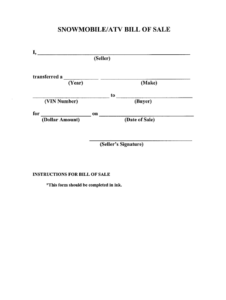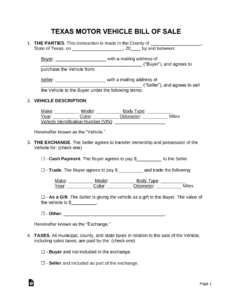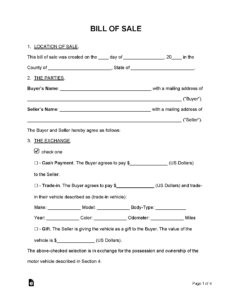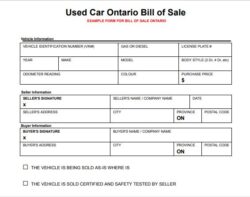Buying or selling a motorcycle is an exciting milestone, whether you are upgrading to a new machine or passing on a beloved ride to another enthusiast. However, beyond the thrill of the open road, there is a crucial piece of paperwork that ensures a smooth and legally sound transfer of ownership: the bill of sale. Think of it as your official handshake, documented and signed, that protects both the buyer and the seller.
While drafting a bill of sale from scratch might seem daunting, a well-structured motorcycle bill of sale template can simplify the entire process. It provides a clear, concise, and legally defensible record of the transaction, ensuring that all necessary details are captured accurately. Using a template not only saves you time but also gives you peace of mind, knowing that you haven’t overlooked any vital information.
Why a Motorcycle Bill of Sale is Your Best Friend
When it comes to transferring ownership of a motorcycle, a bill of sale acts as the official receipt and legal proof that a transaction has occurred. It clearly documents that the seller has transferred ownership of the vehicle to the buyer for an agreed-upon price on a specific date. This document is not just a formality; it is a critical safeguard for both parties involved, helping to prevent future disputes regarding ownership, condition, or payment.
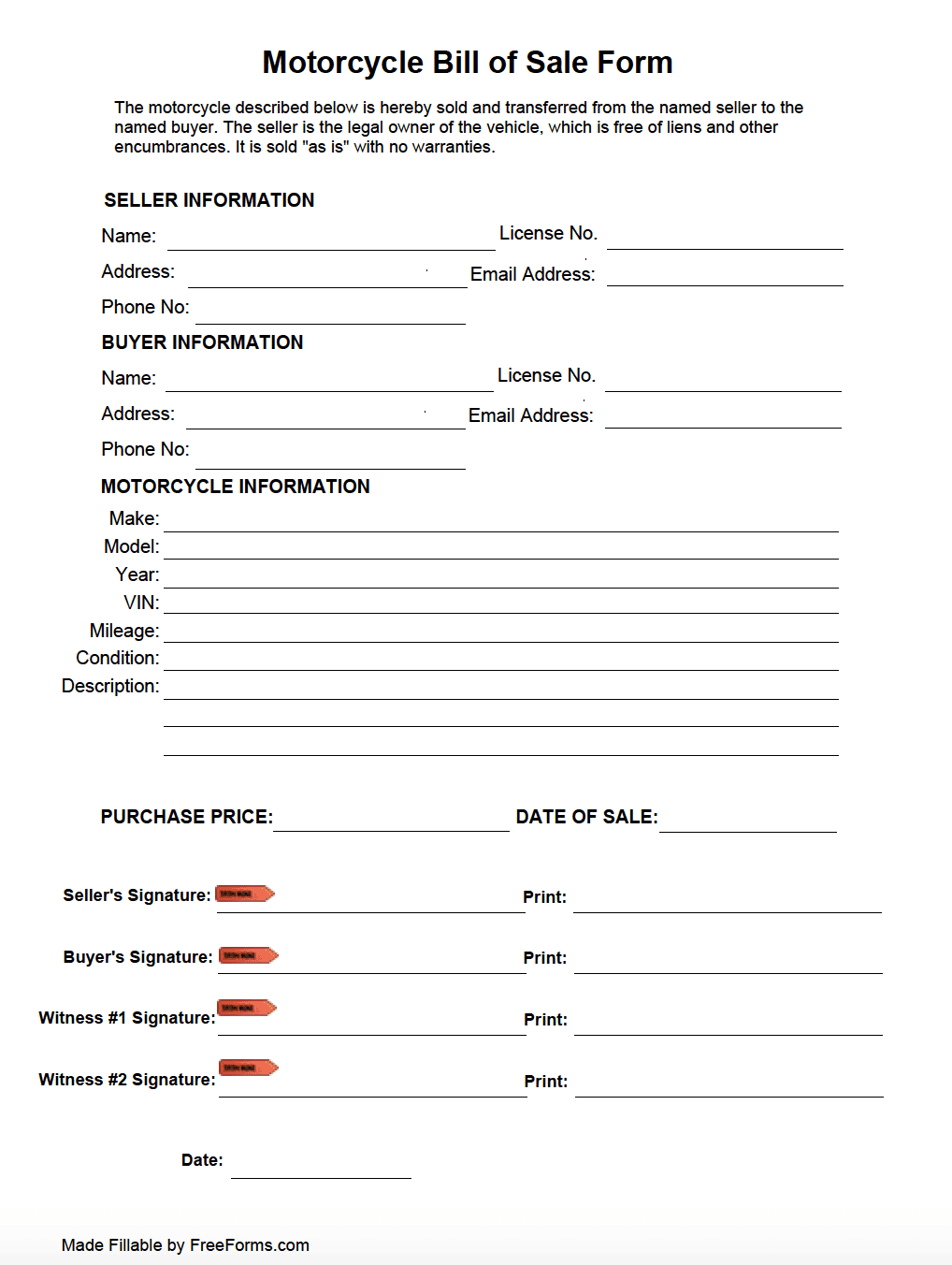
For the seller, a completed bill of sale serves as irrefutable evidence that they no longer own the motorcycle. This is incredibly important for liability purposes, especially concerning accidents or parking violations that might occur after the sale. It effectively severs the seller’s legal connection to the vehicle, ensuring they are not held responsible for actions taken by the new owner.
On the buyer’s side, the bill of sale is typically required for registering the motorcycle with the Department of Motor Vehicles (DMV) or equivalent authority. It proves that you are the legitimate new owner, allowing you to title and register the bike in your name. Without it, you might face significant hurdles in legalizing your new ride, potentially delaying your ability to enjoy it on public roads.
Beyond its legal necessity, a comprehensive bill of sale also provides transparency about the condition of the motorcycle at the time of sale. While not a warranty, it can include clauses where the buyer acknowledges the “as-is” condition, further protecting the seller from claims after the sale. Conversely, it provides the buyer with a documented record of the purchase details, which can be useful for insurance purposes or future resale.
Key Information to Include
To be effective and legally sound, a motorcycle bill of sale template must include several essential pieces of information. Omitting any of these details could weaken the document’s validity and lead to complications down the line. Accuracy and completeness are paramount to ensure a smooth transfer of ownership.
- Seller’s Full Name and Address: Complete legal name and current residential address of the individual or entity selling the motorcycle.
- Buyer’s Full Name and Address: Complete legal name and current residential address of the individual or entity purchasing the motorcycle.
- Motorcycle Details: Comprehensive information about the vehicle, including its make, model, year, vehicle identification number (VIN), odometer reading at the time of sale, and license plate number (if applicable).
- Purchase Price: The exact amount of money agreed upon for the sale of the motorcycle. It’s also wise to specify the payment method (e.g., cash, check, bank transfer).
- Date of Sale: The specific date the transaction took place and the ownership officially transferred.
- Signatures of Both Parties: The legal signatures of both the seller and the buyer, indicating their agreement to the terms.
- Witness Signatures (Optional but Recommended): Signatures from independent witnesses can add an extra layer of authenticity and legal weight to the document, especially for higher-value transactions.
Ensuring that every one of these fields is accurately filled out and all parties sign where necessary will significantly bolster the validity of your motorcycle bill of sale template and provide peace of mind for everyone involved.
Navigating the Transfer Process with Ease
Once you have a reliable motorcycle bill of sale template in hand and are ready to finalize your transaction, the process becomes remarkably straightforward. The template guides you through collecting all the necessary information, making sure no critical detail is missed. This meticulous approach is key to avoiding future headaches and ensures that both parties understand their responsibilities and the terms of the sale.
After the details are filled in, it is crucial that both the buyer and the seller sign the document. Some jurisdictions may also require the signatures to be notarized, which adds an extra layer of legal verification. Even if not strictly required, notarization can provide an additional safeguard, confirming the identities of the signers and the authenticity of their signatures. Always check your local DMV or equivalent authority’s requirements regarding notarization.
Once signed, it is highly recommended that both the buyer and the seller retain a copy of the completed bill of sale for their records. The buyer will need their copy to register the motorcycle and obtain a new title in their name. The seller’s copy serves as crucial proof that they are no longer the legal owner, protecting them from any liability or responsibility related to the motorcycle after the sale date.
Using a standardized motorcycle bill of sale template also simplifies interactions with regulatory bodies like the DMV. When you present a clear, complete, and professionally prepared document, the registration and titling process tends to be much smoother. This prevents delays and reduces the chances of having to return multiple times to provide missing information or correct errors, saving you valuable time and frustration.
Furthermore, having a clear and comprehensive bill of sale can be incredibly useful for insurance purposes. When insuring your newly acquired motorcycle, your insurer will likely ask for proof of ownership and the purchase price. A well-executed bill of sale provides these details instantly, streamlining the process of getting your bike covered and ready for the road.
Whether you are purchasing your dream bike or selling a cherished ride, having the right documentation in place makes all the difference. A clear, accurate, and comprehensive bill of sale protects both parties and ensures a smooth transfer of ownership. It is an essential step that provides peace of mind, allowing you to focus on the joy of riding rather than legal uncertainties.
By taking the time to properly complete this vital document, you are investing in a seamless and legally sound transaction. It’s a small effort that yields significant security, ensuring that your motorcycle journey, whether as a buyer or a seller, starts and ends on the right note.
